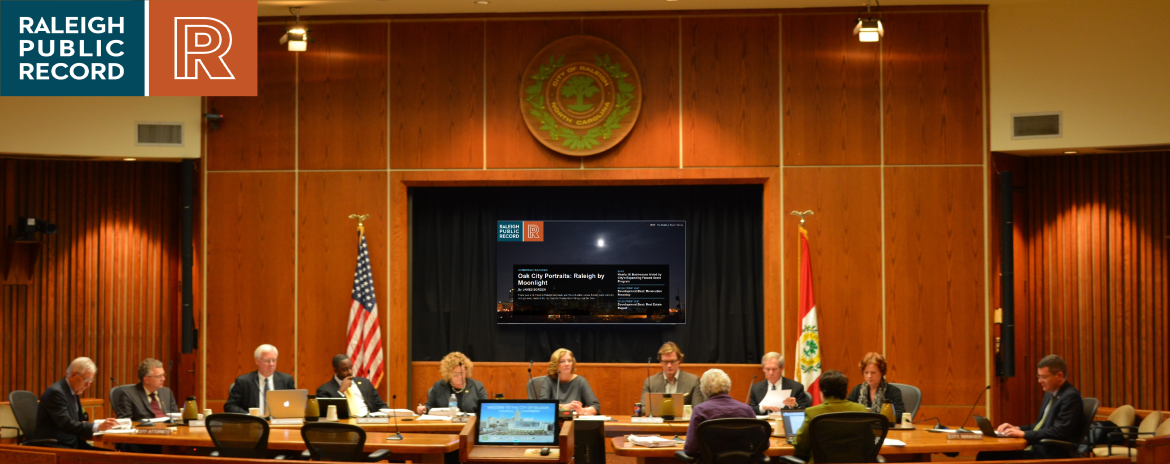On Monday, we previewed what would be coming up at City Council with our Agenda Preview, an in-depth look at the issues scheduled for discussion before council. Today, we bring you The Council Record, an informal but nevertheless comprehensive look at the most recent City Council meeting.
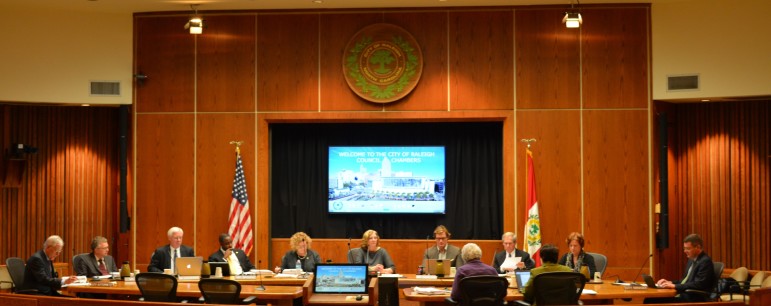
April 19, 2016: 11:30 a.m. Work Session
Once a month, Raleigh’s City Councilors meet in room 305 of the City’s municipal building at 222 West Hargett Street for a working lunch session. This is the first time this feature will cover a work session, and if you were curious: yes, the Councilors get a free lunch during these sessions. In exchange, they have to sit through lengthy presentations from City staff.
On Tuesday, the first of those presentations was titled Water Resource Assessment and Plan Update.
Kenny Waldroup with public utilities told Councilors the idea was to get a look at some “long-range & critically strategic projects.”
Waldroup began the presentation by noting that Raleigh’s service area for water extends beyond the boundaries of the city and serves a total of seven communities with a population of 535,000 as of 2014.
Waldroup went on to say that while the city’s population continues to grow, its overall water use has continued to decline, making it difficult to predict future needs. The current customer base uses about 48 million gallons per day of water; that number is projected to nearly double to 98 million gallons per day by 2045. 90 percent of the water used is returned to the Neuse River.
It has been projected the City could exhaust its current water supply within 20 years. In 2006, work began on developing develop a new water resource for the service area, although initial plans to simply construct a new reservoir were modified to allow for the study of two other alternatives.
A very quick breakdown of the three options follows. Waldroup said the allocations would be “temporary” solutions, although because of the long-range nature of water supply planning, temporary in this case is defined as 30 years.
- Falls Lake Reallocation: Requested volume reallocation was around 4 billion gallons per year at a cost of $42 million.
- Jordan Lake Allocation: Requested allocation of 4.7 million gallons per day at a cost of $500,000 per year.
- Little River Reservoir: In 2007 the City started the process to gain federal approval to dam the Little River; it had spent around $6 million between 2007-2012 exploring this option. Disagreements with the Town of Rolesville have stalled this project. When Waldroup mentioned Rolesville was holding off on an interlocal agreement because of a desire for commercial watershed development, Councilor Kay Crowder was incredulous. Waldroup said they hoped to change the opinions of their partners in watershed preservation “using reasoning or modeling.” Good luck!
When the reallocation process begins to move forward next year, Waldroup said staff will “need Council’s support at a political level.”
The next presentation dealt with a user-fee assessment of the City’s parks system. City Manager Ruffin Hall explained this was part of a multi-departmental effort to look at user fee policies and that the parks department was first.
Allison Bradsher from the City’s finance department said while working on the fee assessment project she had “learned a lot about our parks system and was amazed at all the daily activities and programs they offer.”
“The good thing about this project is that at the end of the day, it offered us validation that what we’re doing for the most part is really in line with public desires,” Bradsher said.
Scott Payne from the City’s parks, recreation and cultural resources department said the consultant they had brought on, GreenPlay, found their recommendations were in line with 95 percent of user fees for the department’s various programs.
GreenPlay broke down these programs into five tiers based on who they benefit. Tier one, for example, contains programs that are beneficial to all people in the community. Tiers four and five, however, are described as benefiting “mostly the individuals who participate” and “only the individuals who participate.”
For Tiers 1-3, Payne said the City is on balance with the consultant recommendations. Tier four is close, although they have some work to do on Tier five.
“Thankfully Tier Five is the smallest percentage of what we offer; we feel very good about what we’ve been doing so far,” said Payne.
Before wrapping up the presentation, Payne said the City should work better to promote the financial assistance it offers to needy families who would otherwise be unable to participate in parks programs.
“It felt important to incorporate this into the policy; it’s the right thing to do and we’ve been doing it, we’ve just never formally stated that we do it,” he said.
April 19, 2016: 1 p.m. Regular Session
As always, the Raleigh City Council afternoon session began with an invocation, led this time by Reverend Shannon Scott of the Mount Vernon Baptist Church. The invocation was followed by the Pledge of Allegiance, led by Councilor Bonner Gaylord. Councilors Corey Branch and Mary-Ann Baldwin were absent and excused from the meeting.
Presentations & Awards
Following a number of special designations and awards — May will be national bike month for which the City has a number of planned activities, a new member will be joining the City’s Human Relations Commission and a recognition of the efforts of Jennifer Martin, President of Shop Local Raleigh, (and a board member at the Raleigh Public Record) in putting together Brewgaloo, the state’s largest craft beer festival scheduled for this weekend — Marcia Brantley from Prevent Blindness North Carolina was on hand to present Councilors with an update on the organization’s efforts.
“Many of us take our vision for granted,” Brantley said.
“It’s not until we start having problems, gradual or drastic, that we realize we need to take care of it.”
Too often, Brantley said, children and adults in North Carolina cannot afford vision care, so Prevent Blindness NC works to ensure these people are able to receive services such as retinal scans and basic tests for near/far-sightedness.
“We may screen someone who’s not doing very well, they’re trying to get glasses so they can get their license and drive to work, and we’re able to help them out.”
Consent Agenda
We predicted in Monday’s Agenda Preview that item 7.3 relating to the Moore Square renovation project would be pulled from the agenda by Councilor Mary-Ann Baldwin in order to recuse herself. We were half-right: Baldwin was absent and did not have to recuse herself, but the item was pulled anyway at the request of Mayor Nancy McFarlane and Councilor Kay Crowder.
As presented in the agenda, item 7.3 related specifically to an Request for Qualifications the City issued in February for a Construction Manager At-Risk to handle the Moore Square park renovation project. Staff was requesting permission from Council to begin negotiations with their top choice, a collaborative team made up of Whiting-Turner and Holt Brothers. Councilor Baldwin is a VP of marketing and development with Holt Brothers.
McFarlane expressed concern that staff had not included in its packet to Council any information about the specific proposals received.
“I’m curious about the other two firms: nothing tells us what the difference is, nothing speaks to how things were scored,” she said.
Crowder chimed in.
“It would be nice for us to see the top three, and see what the thought process was. You ask us to look at it and approve it, it would be nice in the future to to see these things and know exactly what drove the decision process.”
Staff said while all top three contenders were viable choices, Whiting-Turner/Holt Brothers was chosen in part because of their arboreal and architectural expertise. They also included a detailed “high-level communication plan” for reaching out to surrounding neighbors and businesses that will be affected by the project.
The item was sent to the Growth and Natural Resources Committee, where Councilors will receive more in-depth information on the proposals. We have requested copies of said proposals, and will update this post once they are received.
Councilor Stephenson asked to pull item 5.1 from the agenda, related to the disposition of City-owned property.
In August, the Housing and Neighborhoods Department issued an RFP for the sale of 14 city-owned lots on Oakwood Avenue, Idlewild Avenue, East Jones Street, East Lane Street, and Seawell Avenue. On October 29, five responses were received for the purchase of and creation of affordable homes on the 14 lots.
Stephenson wanted to know exactly how affordable these homes would be.
“This housing if for families or individuals earning less than 80 percent of the area median income; what does that translate to in terms of home prices?”
Larry Jarvis, the City’s director of housing and neighborhoods, said they were governed by the price limits established by the Department of Housing and Urban Development.
“$202,000 is the super-limit: these will all be priced substantially less than that.”
The item, which called for setting a May 3 public hearing on the proposed sale, was approved unanimously.
The final item pulled was 7.6, which dealt with a matching City grant for work by the NCDOT on the Capital Boulevard bridge repair projects on Peace Street and Wade Avenue. Crowder wanted to ensure that approving the $9.7 million in funding would not take necessary money away from the widening of I-440.
Transportation director Eric Lamb said they anticipate getting some of the money back from the NCDOT as the City qualifies as an impacted property owner along West Street and will receive compensation as a result. While he did not have an exact figure for the cost of the 440 project, he said they were not concerned about being able to cover it.
Crowder asked if there was a way to reduce the enhancements on the bridges in order to bring the cost of this project down.
“I’m not comfortable now going back and changing the designs on the bridges because we’re worried we might not have money for another project,” responded McFarlane.
The motion to approve the grant was then voted on and approved unanimously.
Special Items
The first special item was rezoning case Z-39-15, which would allow for a 78-unit apartment complex on the 1800 block of Trailwood Drive. The applicant had previously requested more time to add more conditions to the case; those conditions were received by the City but without the proper signatures. The applicant requested another two-week extension, which was approved unanimously by Council.
The applicant for rezoning case Z-41-15, which would allow for allow for a five-story neighborhood mixed-use redevelopment on the 3100 block of Hillsborough, also came before Council Tuesday seeking a deferral.
It was not granted.
As with Z-39, Z-41 had been deferred from the previous Council meeting to allow the applicant, Blair Sweeney from Landmark Properties, to add more conditions to the case. Councilor Crowder told Sweeney she was unhappy with the way those conditions turned out.
“Blair, you’re a nice guy,” Crowder said.
“This process has been going on for quite some time; the part for me that’s very difficult is that for about four or months there has been a constant education being done with the citizens and city staff of your intentions.
“I think you’ve done a good job of communicating what you want to deliver; what ultimately happened is that the things promised are not in the conditions as written.”
These items included a promise to save the old rooftop tractor sign and to have non-opening windows facing one side of the property. The conditions only state that the developer will make their best efforts to do these things, rather than guarantee they will.
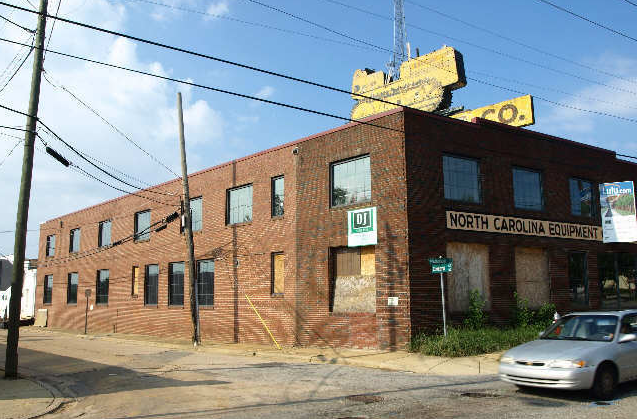
Neighbors wanted the developer to save this old tractor rooftop sign
Attorney Lacey Reaves, speaking on behalf of Sweeney, said they had always made clear that saving the sign depended on approvals that would come after the rezoning approval. Crowder disagreed.
Reaves said many of the conditions were not things that could be promised at this early of a stage; he said their understanding was that they would be further developed through the site plan process.
Councilor Stephenson echoed Crowder’s concerns.
“Our job is to look out for citizens; if the conditions aren’t up to a level where there’s not still all these questions hanging out there, it just shows a lack of due diligence in the process.”
Reaves countered, saying that “If we gave an ironclad commitment and then couldn’t get it approved at the time of site plan approval, then we couldn’t get a building permit.”
Stephenson said the developer was trying to have it both ways.
“You can’t put it in there and say ‘We’ll do it if we can,'” he argued.
Instead of granting an extension, Councilors decided to vote on the case: it was disapproved. At this point, Landmark will either have to sell the land, develop a project that fits within the current zoning classifications or submit an updated rezoning request.
The next special item involved a lengthy presentation and discussion on a proposed widening of Six Forks Road.
Four options for the project were presented to Council; Stephenson said he didn’t like the idea of doubling the capacity of Six Forks to 50,000 trips a day, he said, will go against the work Kane Realty has done to turn North Hills into a more walkable, urbanized environment.
The majority of stakeholders in the project, Stephenson said, had asked for a four-lane option. He would also want to see medians added, along with wider sidewalks and bike lanes.
Councilor Gaylord, the General Manager at North Hills, made a motion to accept that staff further study a four-lane option with an additional, dedicated bus lane added in each direction. It was approved unanimously.
City Manager’s Report
- Hillsborough Street Project Update: Chris Johnson from public works told Councilors that the bids for work on Phase II had been opened last week — Pipeline Utilities was the apparent low bidder — and that following an official award, the next step would be a public outreach campaign. The goal would be to inform neighbors, businesses and other stakeholders of what to expect, along with providing them details of many of the benefits the renovation will bring, including enhanced bicycle and pedestrian infrastructure and a variety of streetscape improvements. The project is anticipated to cost around $12.8 million.
- Raleigh-Cary Rail Crossing Study: For the last year-and-a-half, the City has been working with a number of partners to “evaluate potential improvements to the at-grade highway/rail crossings from NE Maynard Road to Gorman Street and to study how changes at the crossings will affect future land uses and the community.” Todd Delk from planning told Councilors they had worked to address three primary concerns: 1. How can we improve safety at rail crossings, 2. How should we cross railroads and 3. How will land use affect those areas. Council voted to approve the study, which means the City’s future land use map will be updated, and funding will have to be obtained for the suggested improvements. The study can be found here.
- Dorothea Dix Park Update: Kate Pearce from parks, recreation and cultural resources provided Councilors with update on the preparations for the future master planning for Dorothea Dix. Pearce said they had been going on a “roadshow” meeting with neighbors and community organizations. They are presently hosting a series of walking and bus tours of the grounds. Councilors voted to approve a five-year memorandum of understanding with the Dix Park Conservancy, which will see the group raise between $2-$3 million to help fund the park’s planning process. Once the planning process is complete, it will focus on raising funds for more specific projects at the park. “Many public institutions — museums, zoos what have you, have private fundraising; an endowment enables those tax dollars to go much further than they would on their own. Thank you for this commitment,” Mayor McFarlane said, addressing the Conservancy. McFarlane also called forward Greg Poole, a driving force behind the Dix Park project for the last decade. She thanked him for all he’d done, and presented him with a framed City map of Dix Park.
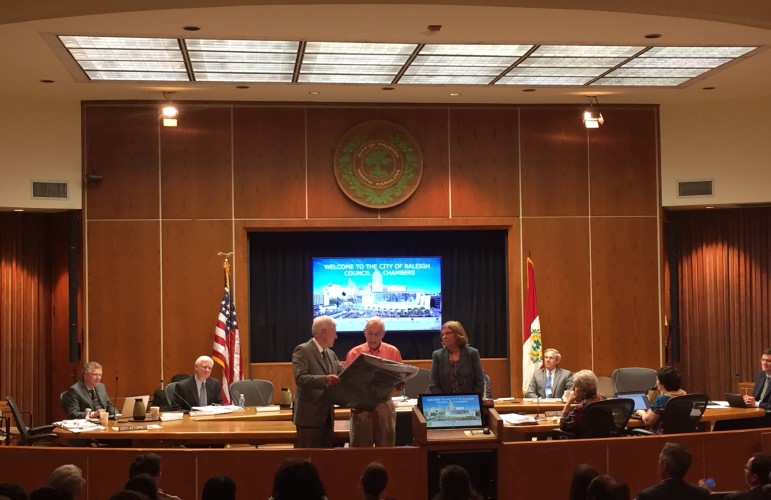
Greg Poole receives his award
Appearance Commission Report
- Outdoor Seating Design Review Recommendations: A three-month review period kicked off in November 2015 for a pilot period for changes to the outdoor seating ordinance. McFarlane said while Council appreciated all the work that had been done on this — the group met weekly for around two hours for the last three months — but that they wanted to send the item to committee. Brian O’Haver, Chair of the Appearance Commission, gave a brief presentation anyway. One of the major issues, he said, dealt with the potential removal of physical stanchions as a way of designating barriers, and instead switch to a medallion system similar to what’s being used in Durham. Additionally, he suggested the City not require “No Alcohol Beyond This Point” signage and prohibit stacking furniture on public property. The case was referred to Council committee. You can read the full report here.
Parks, Recreation and Greenway Advisory Board Report
- Crabtree Creek West Greenway Trail Plan: A public hearing was held March 17 for this plan. The Crabtree Creek West Greenway is a proposed trail connection that extends from the current Crabtree Creek Trail terminus at Lindsay Drive to the eastern boundary of Umstead State Park on Ebenezer Church Road. It’s the final link between Crabtree Creek and Umstead Park. Mike Surasky from the Parks, Recreation and Greenway Advisory board told Councilors that design is complete and that the project will be funded with $4.4 million from a Parks Bond.
Requests and Petitions of Citizens
- Liliya Oleshchuk was the first scheduled speaker, and she wished to appeal an administrative fee/civil penalty, per Health, Sanitation, and Public Nuisance Code Section 12-6005, 12-6006, and 12-6008 related to her home at 500 Somerset Mill Road. Ms. Oleshchuk was not in attendance at the meeting, so staff presented her appeal case: she had been written up for having an indoor couch on her relatively small front porch. Oleshchuk told staff the couch allowed her to occasionally sleep outside, per doctor’s orders. Council denied the appeal.

A photo of the couch in question
- Mark Anthony Ferrell was the next scheduled speaker, and was actually in attendance. He requested additional time to complete work on the house at 420 Montague Lane. Staff said progress on the project, which began in 2012, has been slow, and said Ferrell has been granted a number of extensions. Council approved a final 90-day extension; should he fail to complete the work in that time, he will be subject to fines.
- The next two scheduled speakers were absent. Jennifer Hollar, who had signed up as both the fifth and sixth scheduled speaker, was next to address Council. Hollar said she had moved to Raleigh in 2015, and purchased property in the Oberlin neighborhood. The home was built according to the strict overlay district standards, she said, which capped homes at two stories or 25 feet. She didn’t mind the restrictions, she said “Because I was pretty happy with the character of the neighborhood.” Due to the “or” language in that requirement, however, a number of homes were getting built in her neighborhood, she said, that violated the spirit, if not the letter, of the height restrictions. As an attic with a maximum height of 7.5 feet can be installed without counting as an additional story, the 25-foot requirement has no bearing on how tall a new house can be.The property on her left, Hollar said, had been planned as a three-story home by a developer who had not realized the property was within an overlay district. It was scaled back, she said, but only slightly. She is now concerned that the present owners of the home wish to build an accessory garage in their backyard that, due to the small lot sizes would have a number of detrimental effects on her quality of life, including preventing her from gardening by blocking available sunlight. Although new height requirements by the city use “and” instead of “or,” to improve the situation in Oberlin, a change in City code would be required. “I realize it’s too late for me,” Hollar said, “But hopefully I can prevent someone else from ending up in my situation.” Councilors agreed to discuss the issue further in the Growth and Natural Resources Committee.
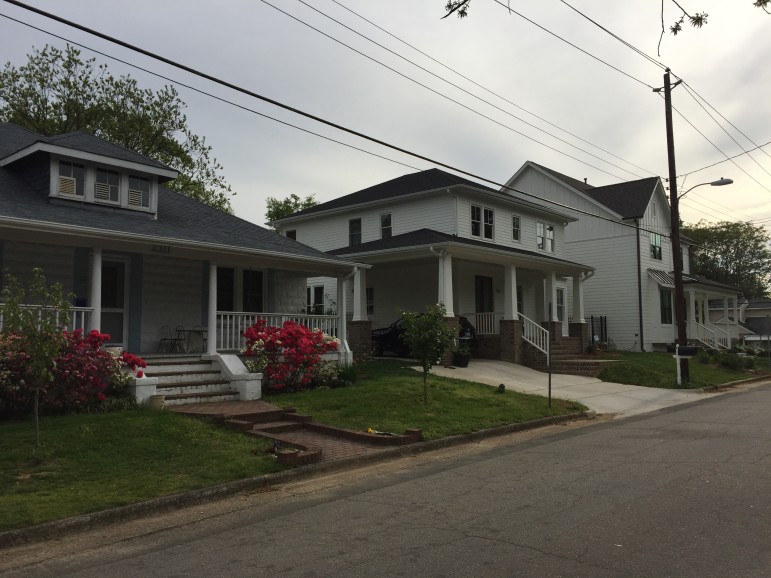
Hollar says her house, in the middle, is being dwarfed by larger homes like the one to the right.
Public Hearings
- The first public hearing dealt with charging abatement costs for properties deemed a public nuisance. In a brief moment of confusion, it appeared that Councilor Crowder both motioned and seconded approval of levying the fines. City Attorney Thomas McCormick later joked that this was the first time in all his years serving Council that he had seen one of them second their own motions. The fines were eventually voted on and approved unanimously by Council.
- Second up was an annexation request for a property known as the Taylor-Long Residence at 9600 Fonville Road in Council District A is requesting annexation into the City. The request was approved unanimously.
- A lengthy presentation/adulation session regarding the City’s two municipal service districts. The downtown district is run by the Downtown Raleigh Alliance, which had a number of supporters in the audience, while the Hillsborough district is run by the Hillsborough Street Services Corporation. Both provide services such as public safety and cleanliness, along with economic development assistance. Council will vote May 3 on whether to continue utilizing these two companies to run the districts.
- Mayor McFarlane paused the public hearings to read a statement that had just been issued by the Greater Raleigh Chamber of Commerce denouncing HB2, which, among other things, prevents cities in North Carolina from requiring businesses to allow patrons to use bathrooms based on gender identity. The controversial law has seen a number of businesses and touring musicians pull out of the state in response.”Over the last few weeks, we’ve heard from many community groups and citizens, we’ve heard from business conferences and conventions and employment recruiters about the negative impact of HB2,” McFarlane said. “We want to take this step to assure the public that we have heard them, and we are doing something about. The Raleigh legislative team has been and is working hard to change HB2; understand, it does not reflect Raleigh’s values, nor has it changed our culture of acceptance and inclusiveness.” Council then passed a resolution supporting the Greater Raleigh Chamber of Commerce’ statement.
- The final public hearing of the day was for rezoning case Z-3-16. It would allow for the creation of Abbington Village, an affordable housing project on a 9.41 acre parcel in far Northeast Raleigh at 2925 Forestville Road. Although the project’s developers, Rea Ventures Group, had met with several property owners to the north of the site and based some of their conditions off those discussions, many neighbors from the Marsh Hollow neighborhood to the south had only learned of the development within the last week. A letter sent to the Homeowners Association was not returned to the developer, but the neighbors said the Association had not passed it along to them either. One of the main concerns was the location of a detention pond just on the other side of a communal recreation area. As quick pedestrian access between the development and the neighborhood is not something the neighbors want, they hope a fence will be built on the property line. They also expressed concerns about traffic, the impact of affordable housing on their properties and the potential change in character Abbington Village could bring to the area. The item was moved to the Growth and Natural Resources committee for further discussion and to give the developers a chance to meet with the Marsh Hollow neighbors.
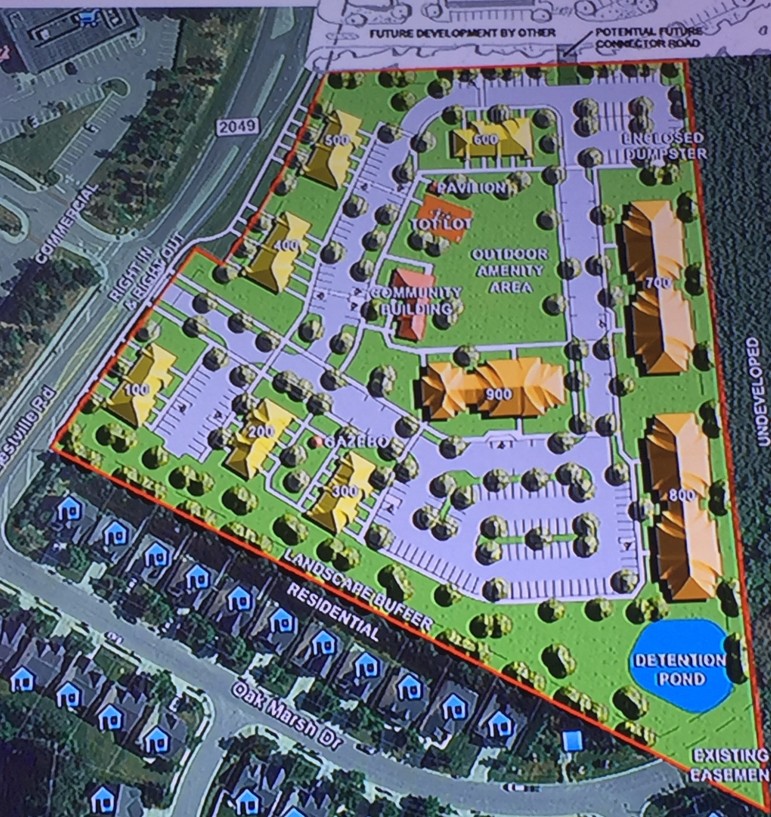
Report of Councilors and Mayor
- Councilor Crowder requested an update on an ethics review process she had been working on with former Councilor Wayne Maiorano. “I think it’s important for Raleigh to avoid a conflict of interest for anything that might come before Council,” she said. Crowder also spoke about encouraging young people to use public transit, as that is often a time when transportation habits are formed.
- Mayor Nancy McFarlane requested that staff look into the possibility of a dog park at Fletcher Park.
- Councilor Dickie Thompson asked for one-time critical need funding for Grace Home, a 501(c)(3) nonprofit that provides transitional housing for women recently released from prison. The $20,000 would go toward desperately needed repairs at the home. The request was approved unanimously by Council.
Editor’s note: a previous version of this post identified the chair of the Appearance Commission as Brian Hamburg. His actual name is Brian O’Haver. We apologize for the error.
